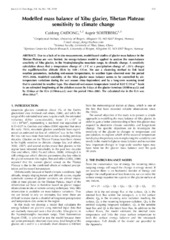Modelled mass balance of Xibu glacier, Tibetan Plateau: sensitivity to climate change
Journal article, Peer reviewed
Published version
Permanent lenke
https://hdl.handle.net/1956/4627Utgivelsesdato
2010-06-01Metadata
Vis full innførselSamlinger
- Geophysical Institute [1198]
Originalversjon
https://doi.org/10.3189/002214310791968467Sammendrag
Due to a lack of in situ measurements, model-based studies of glacier mass balance in the Tibetan Plateau are very limited. An energy-balance model is applied to analyse the mass-balance sensitivity of Xibu glacier, in the Nyainqêntanglha mountain range, to climatic change. A sensitivity calculation shows that a temperature change of ±1°C or a precipitation change of ±35% changes the equilibrium-line altitude (ELA) by 140±125 m. We use a clustering method to link local weather parameters, including wet-season temperatures, to weather types observed over the period 1955–2006. Modelled variability of the Xibu glacier mass balance seems to be controlled by airtemperature variations during the wet season (May–September) and by a long-term warming trend that is unrelated to weather type. The observed wet-season temperature trend of 0.23°C (10 a)–1 leads to an estimated lengthening of the ablation season by 8 days at the glacier terminus (5000ma.s.l.) and by 23 days at the ELA (5590ma.s.l.) over the period 1966–2005. The calculated rise in the ELA was 49m(10 a)–1.
